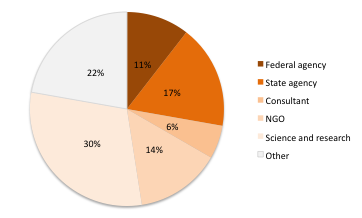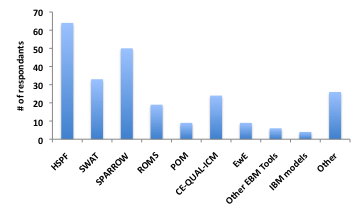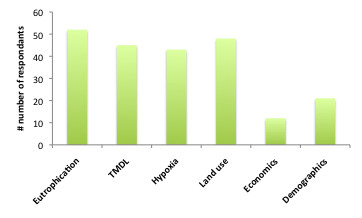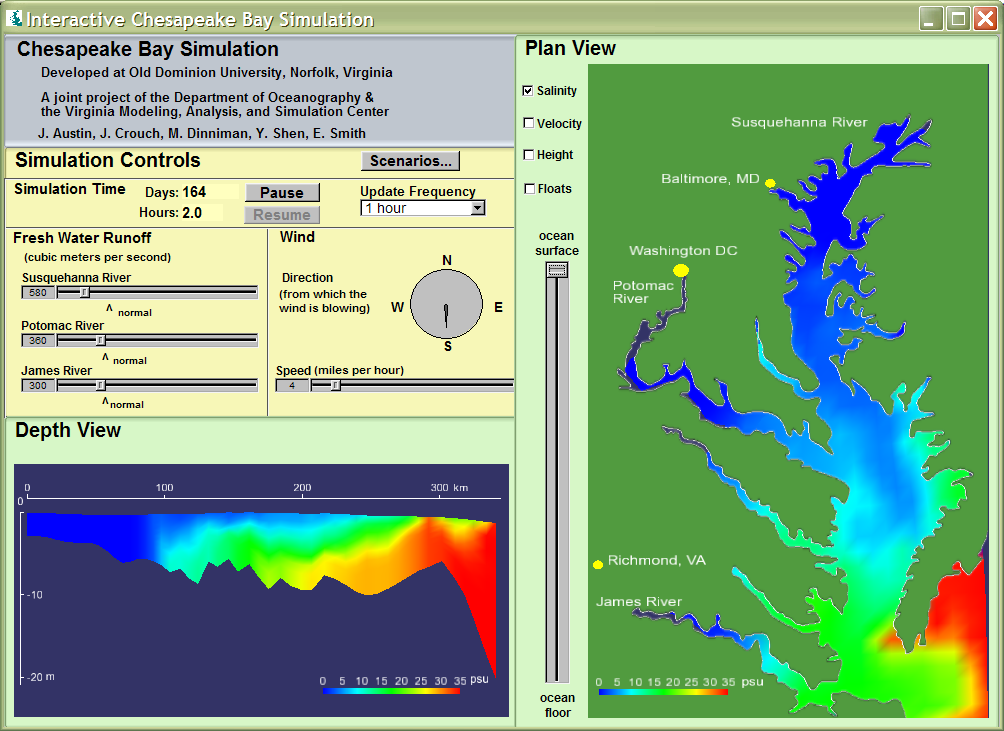Chesapeake Community Modeling Program
the CCMP Newsletter | October 2009
Volume 2, Issue 4
Introduction
The CCMP has been busy this summer gearing up for the Chesapeake Modeling Symposium 2010 scheduled for May 10-12, 2010 in Annapolis, Maryland. More information about that is below. Our quarterly steering committee meeting took place on October 5.

Contents
1. CCMP News in brief
2. News from other communities
3. Open Source on the March
4. Featured Modeler: Alexey Voinov
5. Featured Model: CHIMP
6. Other Events
1. CCMP News in Brief
ChesMS`10
CCMP has been busy planning and organizing the second Chesapeake Modeling Symposium to be held May 10-12, 2010 in Annapolis, Maryland. The theme for the next symposium is “Community Modeling for Management, Research and Restoration Decision Support”. A primary goal of the symposium is to bring together members of both the model developer and user communities in an environment that will hopefully foster communication and interaction between the two groups.
We have received numerous proposals for Special Sessions which will provide the Symposium an exciting range of presentations from model development through application. Registration is currently open and after registering, abstracts can be submitted for either an oral or poster presentation.
The Symposium will be held at the Doubletree Annapolis Hotel. The Early-bird registration rate of $180 ($105 for students) is in effect until March 5, 2010. Thereafter, rates increase to $210 ($135 for students). Registration includes three days of Symposium admission, including daily continental breakfast, lunch and afternoon snacks, as well as all symposium materials. Also included are two catered poster sessions on the evenings of May 10th and 11th.
Check out the ChesMS10 web site for more detailed information!
Future Modeling Suite

Responder make-up

Knowledge of Bay Models

Database use

Issues to be helped by modeling
At the EBM conference in Baltimore, Maryland last March, CCMP distributed a survey entitled “A vision for a Chesapeake modeling suite”. The survey was made available in paper format at the conference and participants were informed that they could take the survey online as well. Response to the survey was moderately successful. Alexey Voinov informed the Chesapeake Bay Program Modeling Sub committee about the results of the survey at their meeting in July. There was general agreement that the survey would provide useful information and that CCMP should make direct requests for responses from members of the larger Chesapeake environmental management community. The survey was redistributed and, combined with the responses from the EBM conference, we now have 150 responses.
We provide here a summary of responses to some of the questions.
Responder make-up: It appears that there was a good distribution of disciplines represented in the pool of respondents. The category with the most respondents was “Other” and these individuals were employees of organizations including conservation districts, local governments (county, town, city) and river basin commissions among others.
Knowledge of Bay Models: The pool of respondents appeared to be relatively well informed regarding the environmental models available with 91 of 150 having knowledge of at least one Bay model. Some had no knowledge of the ones listed in the survey but indicated others of which they were aware.
Database use: Based on survey responses, it appears that the most popular source of data for Chesapeake Bay is the Bay Program database.
Use of Models: Asked if model output was used in their organization’s decision making, 75 respondents said yes and 37 said no (38 no-response). Of those who said no, 24 indicated that they thought model output could be used.
Issues to be helped by modeling: Of the choices given for issues that could be helped by modeling efforts, eutrophication was the top pick followed closely by land use, TMDLs and hypoxia. Some of the more popular write-in responses included climate change, fisheries and non-point pollution. In the chart, the Demographics category include social dynamics, population growth, consumption, etc.
A more detailed summary of responses will be made available on the CCMP web site soon.
2. News From Other Communities
Comparative Risk Assessment Framework and Tools (CRAFT)
 Comparative Risk Assessment Framework and Tools is structured decision framework developed by the Eastern Forest Environmental Threat Assessment Center to help forest mangers make difficult decisions based around the National Environmental Policy Act (NEPA). From the web site “At its core, CRAFT relies on a system of using probabilities to capture and understand the relationships among objectives, actions, and consequences. Designed with planning teams in mind, CRAFT follows the requirements of the National Environmental Policy Act (NEPA), however aspects of this method can be widely adopted by other audiences.”
Comparative Risk Assessment Framework and Tools is structured decision framework developed by the Eastern Forest Environmental Threat Assessment Center to help forest mangers make difficult decisions based around the National Environmental Policy Act (NEPA). From the web site “At its core, CRAFT relies on a system of using probabilities to capture and understand the relationships among objectives, actions, and consequences. Designed with planning teams in mind, CRAFT follows the requirements of the National Environmental Policy Act (NEPA), however aspects of this method can be widely adopted by other audiences.”

Example Bayesian Belief Network for an invasive plant
During the process, a team of stakeholders meet to decide what their objectives are. These objectives and perspectives of team members are used to build a conceptual model to help map the issue and potentially identify opportunities for solutions or additional uncertainties that had not previously been identified. Alternatives are then identified (i.e. – do nothing, mitigate or eliminate the problem). Based on the conceptual model and alternatives variables are identified to model in a Bayesian Belief Network. The results of this exercise are used to determine possible environmental effects of each of the assembled alternatives. A decision can then be made on whether a single alternative or combination of alternatives is the best approach to solving the issue.
 Maximum wave amplitude distribution from the 9/29/09 event off of Samoa
Maximum wave amplitude distribution from the 9/29/09 event off of SamoaDeep Ocean Assessment and Reporting of Tsunamis (DART)
 On Sept 29, 2009 a magnitude 8.0 earthquake occurred 195 km south of Apia, Samoa. A forecast of the Tsunami generated from this event was generated in real time using data from the DART network of observation buoys and the MOST (Method of Splitting Tsunami) model. The MOST model simulates three processes of Tsunami evolution: Earthquake, transoceanic propagation and inundation of dry land.
On Sept 29, 2009 a magnitude 8.0 earthquake occurred 195 km south of Apia, Samoa. A forecast of the Tsunami generated from this event was generated in real time using data from the DART network of observation buoys and the MOST (Method of Splitting Tsunami) model. The MOST model simulates three processes of Tsunami evolution: Earthquake, transoceanic propagation and inundation of dry land.
More about the Tsunami forecasting system and the interplay of models and monitoring that comprise it can be found at the NOAA Center for Tsunami Research homepage . There is also a stunning animation of the modeled Tsunami wave propagation across the Pacific for the 9/29/09 event.
3. Open Source on the March
Ecotrust Watershed Locator
 Ecotrust has developed a web based application that allows users to determine watershed boundaries by clicking on a map, entering a zip code or by watershed name. The application allows the user to see three different levels of watershed and access relevant statistics at each level.
Ecotrust has developed a web based application that allows users to determine watershed boundaries by clicking on a map, entering a zip code or by watershed name. The application allows the user to see three different levels of watershed and access relevant statistics at each level.
 Ecotrust Watershed locator
Ecotrust Watershed locatorThe application was developed using open source software (PHP, Mapserver, PostGIS, OpenLayers and Tilecache) to allow users to investigate the watersheds of Pacific Salmon territory of North America. It can be adapted to other areas and the source code is available free and open source under the GPL 2 license.
From the web site "When a user submits an address search, the Watershed Locator sends a request to the Yahoo! Geocoder service. If the geocoder is able to identify the address, it returns its location in the form of a latitude/longitude coordinate pair. We then use this coordinate pair to perform a watershed search on our server, using PostGIS to identify the Pacific salmon-territory watershed within which the given coordinate falls. This watershed information is then returned to the web browser." You can check out the application here.
Open Access Publishing
There has been a trend in recent years of academics turning to open access journals for the publication of scholarly articles. In open access publishing, journals are published online and are free. This model has come under fire from traditional journals which claim that it deprives them of the needed income to support editing and peer review. In a major show of support and what can only be seen as a sign of things to come, five major universities entered into a “Compact for Open Access Publishing Equity”. Under this compact, open access journals will be paid for the publication of articles by the university’s faculty.
The motivation for the compact is an open access journal article “Equity for Open-Access Journal Publishing”. Participating institutions are Cornell University, Dartmouth College, Harvard University, Massachusetts Institute of Technology, and the University of California at Berkeley. The compact can be seen here.
4. Featured Modeler: Alexey Voinov
 International Institute for Geo-information Science and Earth Observation (ITC)
International Institute for Geo-information Science and Earth Observation (ITC)
P.O. Box 6, 7500 AA Enschede
The Netherlands
- 1978 M.S. Moscow State University, Applied Mathematics
- 1982 Ph.D. Moscow State University, Biophysics
As Alexey moves on to new horizons teaching at the International Institute for Geo-information Science and Earth Observation (ITC) where he is an associate professor in the Natural Resources department, we felt it is only fitting to have him as our featured modeler. Alexey was CCMP Program Coordinator from 2007 until August of this year. During his time at CCMP, Alexey coordinated the highly successful Chesapeake Modeling Symposium, worked to get CCMP included in the Community Surface Dynamics Modeling System (CSDMS) as a Chesapeake Focus Research Group, and made CCMP a dynamic member of the internet community with a highly interactive web site and wiki.
Alexey’s research interests include simulation modeling of ecosystems, environmental management and decision support and sustainability and economic development. Alexey is a strong proponent of participatory modeling which is centered around involving stakeholders in the entire modeling process. Because stakeholders have input from the initial discussions of what is to be modeled and inception of the model, it is believed that they are more likely to believe in and use model output.
5. Featured Model: CHIMP – Chesapeake Interactive Modeling Project
 The Chimp GUI
The Chimp GUICHIMP is a pilot project that was funded by the state of Virginia. It was developed by Jay Austin, Large Lakes Observatory, U. Minnesota, Jessica Crouch, Mike Dinniman, Yuzhong Shen, John Klinck, Elizabeth Smith, and Lee BelforeIt from Old Dominion University. CHIMP is based on the Regional Oceanic Modeling System (ROMS) and allows the user to change wind speed and velocity as well as fresh water forcing to identify the effects on Bay circulation. CHIMP is meant to be used in a classroom setting to teach students about circulation in Chesapeake Bay. It is easily downloaded as a Windows based executable and has a highly graphical user interface that updates circulation patterns in real-time.
CHIMP was designed to be easily adaptable to other geographic regions as well. More savvy users can take advantage of the bio-chemical and sediment models that are built in as parts of ROMS
6. Other Events
 The Mid-Atlantic Coastal Ocean Observing Regional Association will be holding its annual meeting November 17 and 18 at the Renaissance Hotel in Portsmouth, VA. You can register online at the MACOORA web site.
The Mid-Atlantic Coastal Ocean Observing Regional Association will be holding its annual meeting November 17 and 18 at the Renaissance Hotel in Portsmouth, VA. You can register online at the MACOORA web site.
 The Coastal and Estuarine Research Federation will hold its bi-annual Conference November 1-5 in Portland, Oregon. You can register online here.
The Coastal and Estuarine Research Federation will hold its bi-annual Conference November 1-5 in Portland, Oregon. You can register online here.
 The Ocean Observatories Initiative will be holding a Science Workshop November 11-12, 2009 in Baltimore, MD. Presentations will focus on the OOI network construction design, sensor arrays, construction timelines and data access issues. You can register online here.
The Ocean Observatories Initiative will be holding a Science Workshop November 11-12, 2009 in Baltimore, MD. Presentations will focus on the OOI network construction design, sensor arrays, construction timelines and data access issues. You can register online here.
Chesapeake Bay Executive Order
The public comment period for the Chesapeake Bay Executive Order begins November 9, 2009. More information can be obtained here.
Chesapeake Community Model Program
http://ches.communitymodeling.org/
Chesapeake Research Consortium
Edgewater, MD
410-798-1283